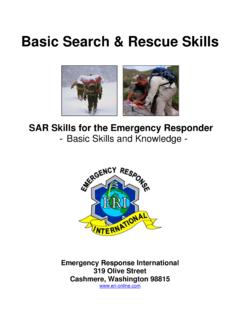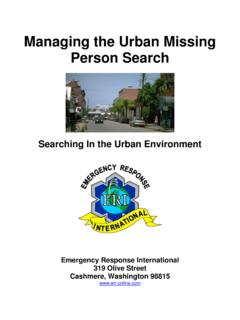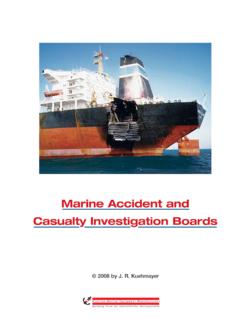Transcription of Management Land Search Operations - eri …
1 Management of land Search Operations Plan of Instruction For Management of land Search Operations - Basic A World Standard for Planning & Management In Search Management of land Search Operations 2 Background The term SAR denotes two separate functions; first Search and second rescue. Rescue utilizes proven procedures along with a high degree of technical skill for victim retrieval. With known victims in known locations, the principle problem involves devising the quickest method of removing that individual from danger to a place of safety and providing medical aid. On the other hand, Search for missing or lost subjects often involves sophisticated science, and many investigative techniques including: statistics, probability, human behavior and interviewing.
2 These are but a few of the standard tools used in land Search strategies. Traditionally, Search and rescue systems provide the response for missing, overdue, lost, injured, or stranded people, in outdoor environments. However, SAR and more specifically the function of Search now regularly surfaces in rural and urban settings. In SAR, wilderness takes on several meanings. For instance, most consider wilderness as generally uninhabited and devoid of anything man-made. While this certainly describes natural areas such as large parks and open countryside, it also describes urban areas after devastation by natural forces such as the recent earthquakes and tsunamis in Japan or the East Coast after Hurricane Sandy. The major flash flooding in Colorado during 2013 is another good example.
3 Even the explosion and crash of Pan American Flight 103 in Lockerbie, Scotland, decades ago proved to be one of the largest Wide Area Search Operations for evidence and human remains in Europe s history. The Search for all the pieces of the space shuttle Columbia across Texas is another example of events pertaining to Wide Area Search . It would be difficult to estimate the total demand for SAR services around the world today. Some estimate the numbers of missions in the alone, exceed 150,000 every year. SAR refers to emergency situations that vary from nation to nation as much as the responders vary in the way they provide relief to persons in distress. SAR programs, equipment and personnel vary geographically in accordance with local needs and also the requirement for Wide Area Search techniques.
4 SAR plays an extremely important role in virtually every disaster, fire response, law enforcement and even many EMS emergencies. Comprehensive emergency Management continuously benefits from ongoing SAR Operations . Those Operations provide a training ground and experience building opportunities for disaster response capabilities at the most elementary level. Management concepts used in SAR Operations establish a foundation for providing a response to larger scale emergencies and disasters. Nearly every type of hazard mentioned in Comprehensive Emergency Management Plans (state and local) require Search and rescue as an Emergency Support Function. Management of SAR Operations ranges from directing the actions of a few responders in a small community, to managing an effort involving hundreds or even thousands of searchers in larger urban calamities.
5 The varieties of environments and situations span mountains and heavily forested terrain, coastal and inland environments, all with numerous threats to human safety. Often, these larger situations also involve several political subdivisions and the coordination of both air and ground resources. Local governments and any other agencies or organizations that participate in SAR response must practice cooperation and coordination among diverse multi-skilled responders. From a comprehensive perspective, this course provides the foundation for planning efforts and cooperation crucial to a fully integrated emergency response system at the local level. The New Managing land Search Operations Training Courses The Management of land Search Operations original course was designed for those who have the responsibility to plan, prepare for, and respond to Search Operations for missing or lost people in wilderness, rural, or urban environments.
6 The course has now been divided into two integrated, but sequential training programs. The split from the original 5-day MLSO curriculum is aimed at both reducing the costs of training and also targeting operational functions. The split into two courses has also proven to be more conducive to normal work schedules as well. 3 Original Goals and Objectives The original 5-day curriculum was designed to provide a comprehensive methodology in Search for use by local government jurisdictions and land Management agencies. That objective has not changed. The methods described in both the Basic and Advanced Search Planning courses are used for evidence searches in many police Operations as well as prison breaks. Neither of these courses are field skills training. They are Management oriented.
7 Participants learn how to plan for, organize and manage a Search effort for missing or lost persons using the Incident Command System (NIMS ICS) as the accepted Management structure. Both courses emphasize the right resources to do the job, reflex tasking based on Lost Person Behavior research in the International Search and Rescue Incident Database, and the correct application of the "science" of Search theory and planning. Participants find out how to properly manage a Search effort for a lost or missing person in an effective manner. Small group discussion and case study tabletop map exercises are used periodically throughout both the Basic and Advanced courses. Dividing the Managing land Search Operations Course For decades the ERI 5-day basic course focused on two comprehensive areas: The first centered on the overall organization/structure and Management of a response effort to find a missing or lost person.
8 Course emphasis included logistics, resources, organizational structure, planning, SAR hazard vulnerability assessments, documentation, and rudiments of investigation, interviewing and protocols for suspending the operation. In recent years we added Lost Person Behavior as another foundation concept in our basic approach. The second area of emphasis in the ERI longer course focused on Search Planning. This aspect of the SAR incident has received increased emphasis over the past half-decade. This function represents a discipline unto itself. Started in the 1940 s under the banner of Operations Research, the Search planning component describes a special resource within the Management structure of a Search incident. Because this function in Search is so important on complicated or extended Operations , ERI has endeavored to at least include the rudiments of this discipline in all basic courses.
9 The rationale behind this emphasis is that any extended operational Search must be based on specific documentation and numerical assessments initiated early in the operation. Specific decisions about tactics and numbers of resources must be based on verifiable operational procedures that are repeatable in a wide array of environments. The Split Far more local agency personnel and designated volunteer responders will be involved in first-on-scene Operations than will ever be involved in protracted or extended searches. The bottom line is that while the numbers of incidents are not necessarily going down, planning for rapid first response based on sound Management principles solves a good number of Search problems fairly quickly. Volunteer overhead team members still need to be familiar with Search nomenclature and protocols, multi-organizational structure and responsibilities, as well as the basic concepts of effective Search .
10 In addition, local resources and capabilities must be matched with reflex tasking tied to the growing research databases for lost subject behavior. Early documentation combined with basic numerical assessments still ensures effective Search Operations in all cases both simple and complex. All of these basic components are contained in the initial three-day Basic Management of land Search Operations . For years many in the SAR community have stated that Probability Theory (or formal Search Planning) and the use of mathematics is really not necessary in Search because the majority of incidents are over in 12 to 24 hours. This off hand reference, based on gut feeling and anecdotes, is now coming into focus as more statistical data builds within the International Search and Rescue Incident Database (ISRID).










